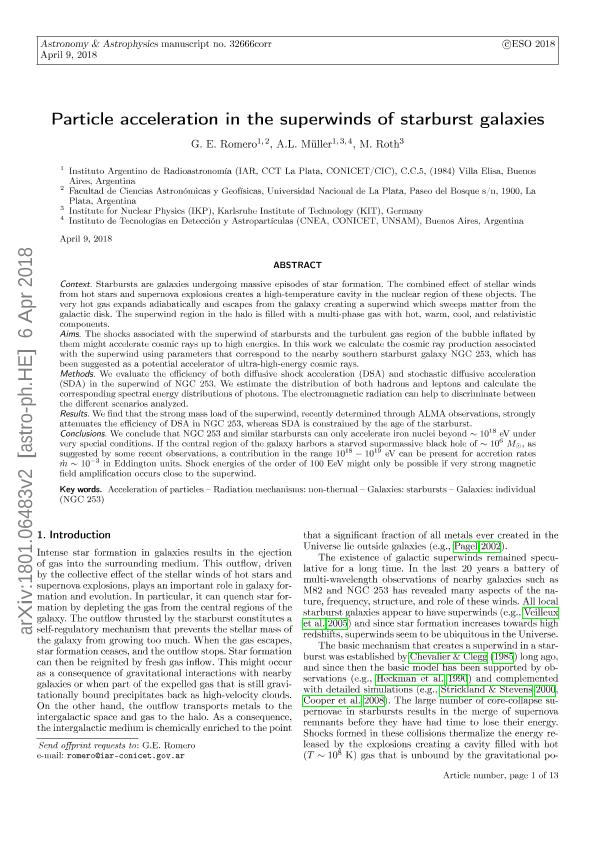Mostrar el registro sencillo del ítem
dc.contributor.author
Romero, Gustavo Esteban

dc.contributor.author
Müller, A. L.
dc.contributor.author
Roth, M.
dc.date.available
2019-08-28T19:52:03Z
dc.date.issued
2018-08
dc.identifier.citation
Romero, Gustavo Esteban; Müller, A. L.; Roth, M.; Particle acceleration in the superwinds of starburst galaxies; EDP Sciences; Astronomy and Astrophysics; 616; A57; 8-2018; 1-14
dc.identifier.issn
0004-6361
dc.identifier.uri
http://hdl.handle.net/11336/82428
dc.description.abstract
Context. Starbursts are galaxies undergoing massive episodes of star formation. The combined effect of stellar winds from hot stars and supernova explosions creates a high-temperature cavity in the nuclear region of these objects. The very hot gas expands adiabatically and escapes from the galaxy creating a superwind which sweeps matter from the galactic disk. The superwind region in the halo is filled with a multi-phase gas with hot, warm, cool, and relativistic components. Aims. The shocks associated with the superwind of starbursts and the turbulent gas region of the bubble inflated by them might accelerate cosmic rays up to high energies. In this work we calculate the cosmic ray production associated with the superwind using parameters that correspond to the nearby southern starburst galaxy NGC 253, which has been suggested as a potential accelerator of ultra-high-energy cosmic rays. Methods. We evaluate the efficiency of both diffusive shock acceleration (DSA) and stochastic diffusive acceleration (SDA) in the superwind of NGC 253. We estimate the distribution of both hadrons and leptons and calculate the corresponding spectral energy distributions of photons. The electromagnetic radiation can help to discriminate between the different scenarios analyzed. Results. We find that the strong mass load of the superwind, recently determined through ALMA observations, strongly attenuates the efficiency of DSA in NGC 253, whereas SDA is constrained by the age of the starburst. Conclusions. We conclude that NGC 253 and similar starbursts can only accelerate iron nuclei beyond ∼1018 eV under very special conditions. If the central region of the galaxy harbors a starved supermassive black hole of ∼106 M∗, as suggested by some recent observations, a contribution in the range 1018-1019 eV can be present for accretion rates ∼ 10-3 in Eddington units. Shock energies of the order of 100 EeV might only be possible if very strong magnetic field amplification occurs close to the superwind.
dc.format
application/pdf
dc.language.iso
eng
dc.publisher
EDP Sciences

dc.rights
info:eu-repo/semantics/openAccess
dc.rights.uri
https://creativecommons.org/licenses/by-nc-sa/2.5/ar/
dc.subject
Acceleration of Particles
dc.subject
Galaxies: Individual
dc.subject
Galaxies: Starburst
dc.subject
Radiation Mechanisms: Non-Thermal
dc.subject.classification
Astronomía

dc.subject.classification
Ciencias Físicas

dc.subject.classification
CIENCIAS NATURALES Y EXACTAS

dc.title
Particle acceleration in the superwinds of starburst galaxies
dc.type
info:eu-repo/semantics/article
dc.type
info:ar-repo/semantics/artículo
dc.type
info:eu-repo/semantics/publishedVersion
dc.date.updated
2019-08-16T16:48:54Z
dc.journal.volume
616
dc.journal.number
A57
dc.journal.pagination
1-14
dc.journal.pais
Francia

dc.description.fil
Fil: Romero, Gustavo Esteban. Provincia de Buenos Aires. Gobernación. Comisión de Investigaciones Científicas. Instituto Argentino de Radioastronomía. Consejo Nacional de Investigaciones Científicas y Técnicas. Centro Científico Tecnológico Conicet - La Plata. Instituto Argentino de Radioastronomía; Argentina. Universidad Nacional de La Plata. Facultad de Ciencias Astronómicas y Geofísicas; Argentina
dc.description.fil
Fil: Müller, A. L.. Provincia de Buenos Aires. Gobernación. Comisión de Investigaciones Científicas. Instituto Argentino de Radioastronomía. Consejo Nacional de Investigaciones Científicas y Técnicas. Centro Científico Tecnológico Conicet - La Plata. Instituto Argentino de Radioastronomía; Argentina. Karlsruhe Institute of Technology; Alemania. Consejo Nacional de Investigaciones Científicas y Técnicas. Oficina de Coordinación Administrativa Parque Centenario. Instituto de Tecnología en Detección y Astropartículas. Comisión Nacional de Energía Atómica. Instituto de Tecnología en Detección y Astropartículas. Universidad Nacional de San Martín. Instituto de Tecnología en Detección y Astropartículas; Argentina
dc.description.fil
Fil: Roth, M.. Karlsruhe Institute of Technology; Alemania
dc.journal.title
Astronomy and Astrophysics

dc.relation.alternativeid
info:eu-repo/semantics/altIdentifier/doi/http://dx.doi.org/10.1051/0004-6361/201832666
dc.relation.alternativeid
info:eu-repo/semantics/altIdentifier/url/https://www.aanda.org/articles/aa/abs/2018/08/aa32666-18/aa32666-18.html
Archivos asociados
